Lithium Refinery Financial Model
Financial Model for a Lithium Refinery
This very extensive 20 Year Lithium Refinery Model involves detailed revenue projections, cost structures, capital expenditures, and financing needs. This model provides a thorough understanding of the financial viability, profitability, and cash flow position of the refinery. Including: 20x Income Statements, Cash Flow Statements, Balance Sheets, CAPEX sheets, OPEX Sheets, Statement Summary Sheets, and Revenue Forecasting Charts with the specified revenue streams, BEA charts, sales summary charts, employee salary tabs and expenses sheets. Over 100 Spreadsheets in 1 Excel Workbook for the closest monitoring of your Lithium Refinery Financials.
Income Statement
A. Revenue
Total Revenue = Σ (Unit Price × Volume) per product.
Growth Rate: 5–10% per year depending on global lithium demand.
B. Cost of Goods Sold (COGS)
Raw Material Cost (spodumene, brine)
Utilities (electricity, water, gas)
Labor (operators, technicians)
Maintenance & Consumables
Depreciation (refinery equipment)
Example:
COGS = Raw Materials + Labor + Utilities + Maintenance + Depreciation
C. Gross Profit
= Revenue – COGS
D. Operating Expenses (OPEX)
Selling, General & Admin (SG&A)
R&D (for process optimization)
Logistics (shipping to end customers)
Environmental compliance
E. EBITDA
= Gross Profit – OPEX
F. Depreciation & Amortization
Depreciation: On plant & equipment
Amortization: Licensing, patents
G. EBIT
= EBITDA – Depreciation & Amortization
H. Interest Expense
On project debt, bonds, and working capital loans
I. Taxes
Corporate Income Tax (adjusted for subsidies or tax credits)
J. Net Income
= EBIT – Interest – Taxes
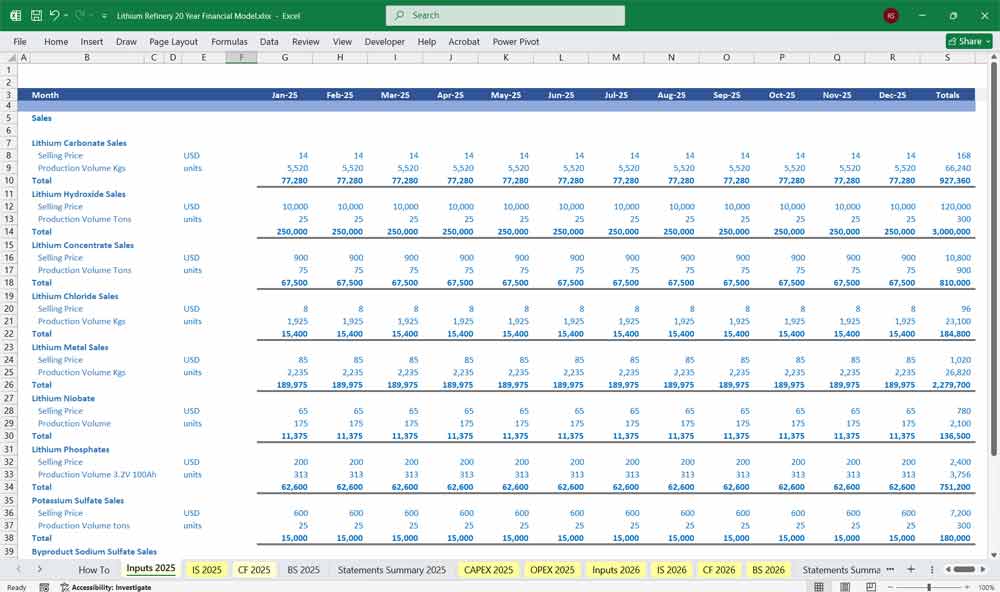
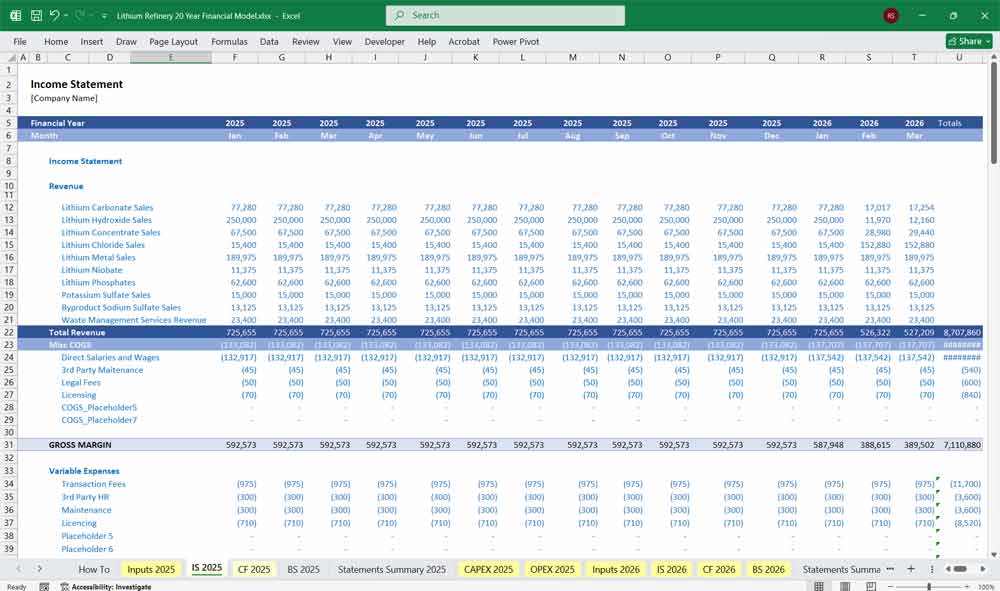
Lithum Refinery Cash Flow Statement
A. Operating Cash Flow
Starts with Net Income
Add back non-cash charges: Depreciation, Amortization
Adjust for working capital changes (Inventory, Receivables, Payables)
B. Investing Cash Flow
CapEx (new equipment, expansion lines)
Asset sales (old equipment)
Technology purchases or IP investments
C. Financing Cash Flow
Equity injections
New debt or repayments
Dividends paid
D. Net Cash Flow
Sum of A + B + C
Links to cash balance in the Balance Sheet
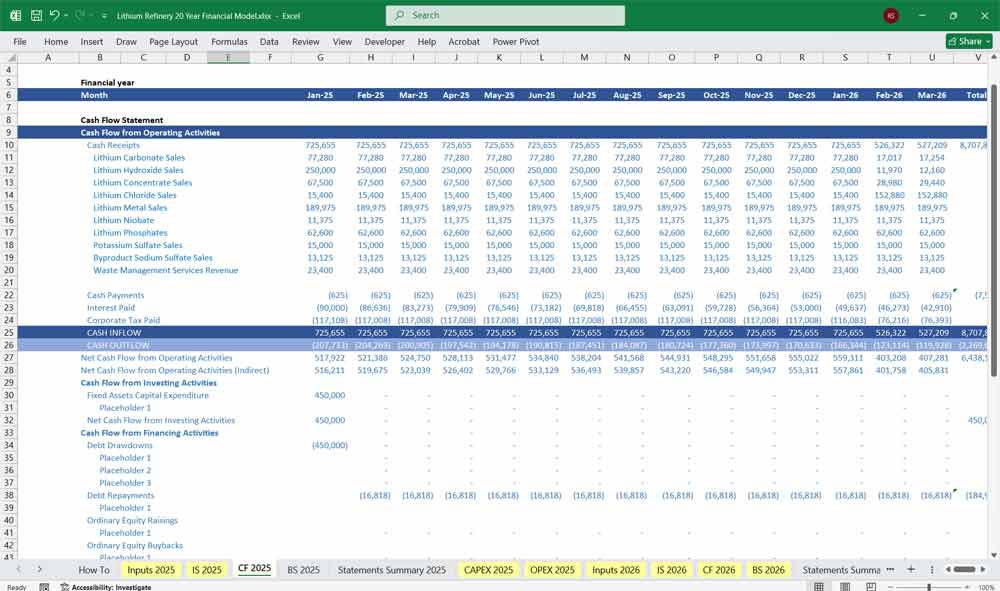
Lithium Refinery Balance Sheet
Assets
A. Current Assets
Cash & Cash Equivalents
Accounts Receivable (from lithium buyers)
Inventory (raw spodumene, in-process lithium, finished lithium products)
B. Non-Current Assets
PP&E: Plant, refinery equipment
Intangible Assets: Patents, licenses
Deferred Tax Assets
C. CAPEX Examples 10 Editable
Crushing And Grinding Equipment
Leaching And Solvent Extraction Tanks
Evaporation Ponds And Liners
- Precipitation And Crystallization Equipment
Liabilities
A. Current Liabilities
Accounts Payable (vendors, mining suppliers)
Short-term loans
B. OPEX Examples 10 Editable
Personnel Costs
Maintenance and Repair
- Transportation and Logistics
- Supplies and Materials
C. Long-Term Liabilities
Long-term project finance loans
Environmental restoration provisions
Equity
Common Stock
Retained Earnings
Other Comprehensive Income

Key Financial Metrics for a Lithium Refinery
Lithium Carbonate and EV Battery Demand
Lithium carbonate is a critical component in the production of lithium-ion batteries, especially for electric vehicles (EVs). As global EV adoption accelerates due to decarbonization efforts and government incentives, the demand for battery-grade lithium carbonate continues to rise sharply. Its role in stabilizing cathode chemistry makes it a preferred material for mass-market EV battery manufacturers.
Lithium Hydroxide and Battery Cathodes
Lithium hydroxide is increasingly favored for high-nickel cathode chemistries used in next-generation lithium-ion batteries, which offer higher energy density and longer range. It is essential for NMC (nickel-manganese-cobalt) and NCA (nickel-cobalt-aluminum) cathodes. With the shift toward performance-centric EVs and stationary energy storage systems, lithium hydroxide demand is projected to outpace lithium carbonate over the next decade.
Lithium Concentrate and Upstream Intermediates
Lithium concentrate, typically in the form of spodumene, is the upstream feedstock processed into refined lithium compounds. It is mined and sold to refiners who extract lithium chemicals for downstream uses. This intermediate product is essential to the supply chain, and its availability directly impacts the global lithium refining capacity.
Lithium Chloride and Industrial Applications
Lithium chloride serves multiple roles in industrial processes, including air conditioning systems, aluminum smelting, and chemical synthesis. Its hygroscopic properties make it valuable in desiccants and specialty chemical production. While smaller in market size compared to battery-grade lithium, its industrial demand is steady and geographically diversified.
Lithium Metal and Aerospace, Special Batteries
Lithium metal is a highly reactive and energy-dense form used in solid-state batteries, defense systems, and aerospace applications. Its high performance makes it suitable for advanced battery technologies and niche sectors where weight and energy density are critical. Although production volumes are lower, it commands premium pricing and strategic interest.
Lithium Niobate and Optical Devices, Semiconductors
Lithium niobate is a specialty crystal compound used in high-frequency optical modulators, photonic devices, and semiconductor components. It enables high-speed data transmission in telecommunications and advanced computing systems. With the rise of 5G, AI, and quantum technologies, demand for lithium niobate is steadily growing in precision electronics markets.
Key Performance Metrics
Gross Margin = (Revenue – COGS) / Revenue
EBITDA Margin
Net Profit Margin
Return on Capital Employed (ROCE)
Debt-to-Equity Ratio
Cash Conversion Cycle
Scenario Analysis
Include dynamic inputs for:
Lithium price fluctuation
CAPEX scenarios
Expansion to additional refining lines (e.g., more lithium hydroxide capacity)
FX impact (export-oriented revenue vs. local costs)
ESG compliance cost assumptions

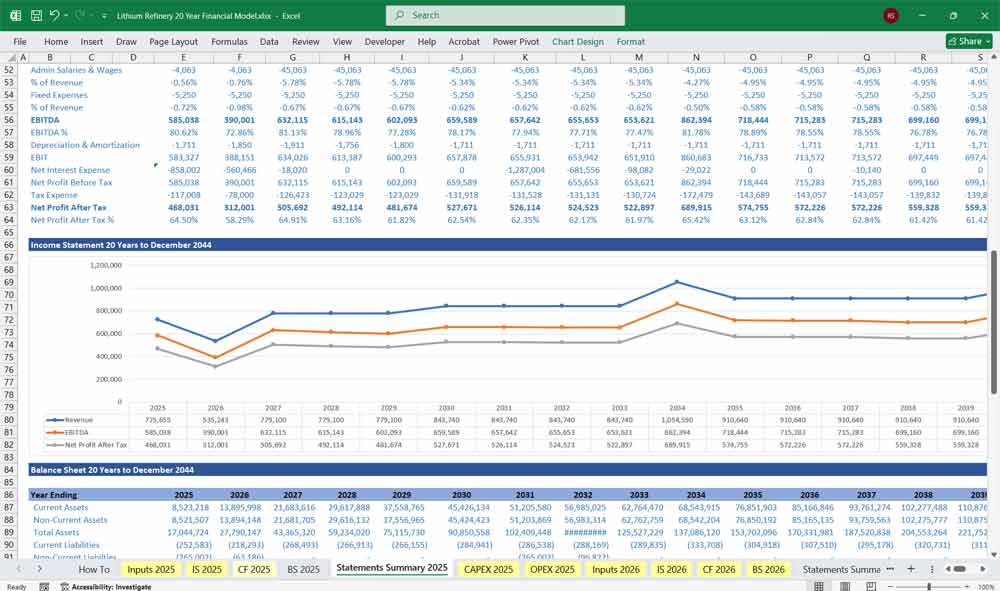
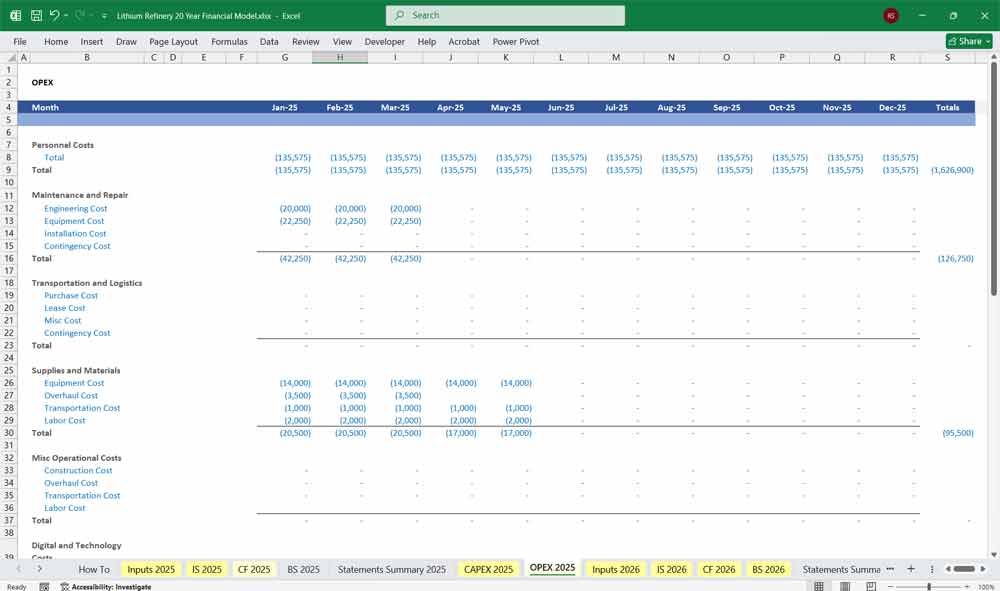
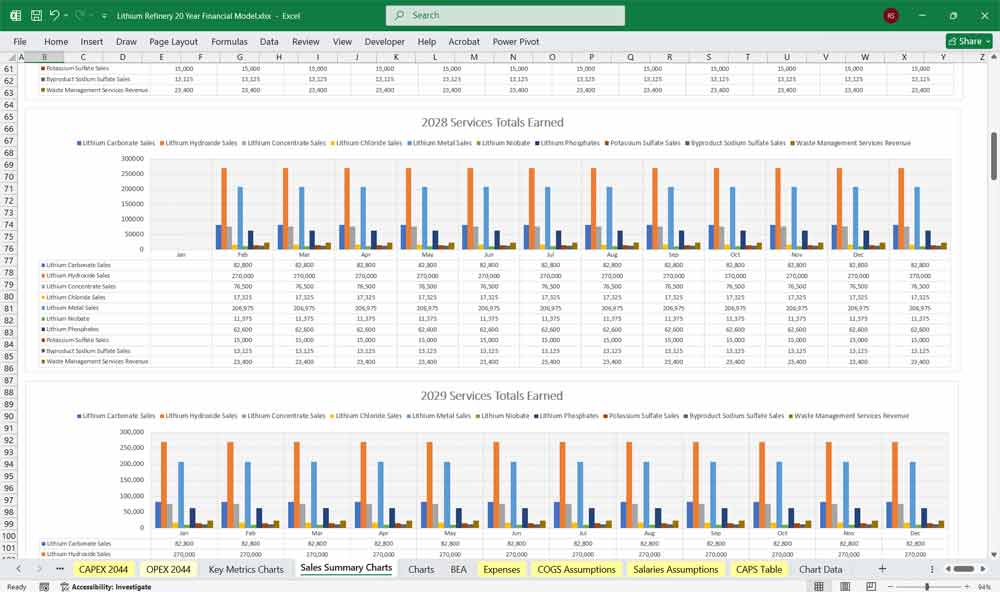

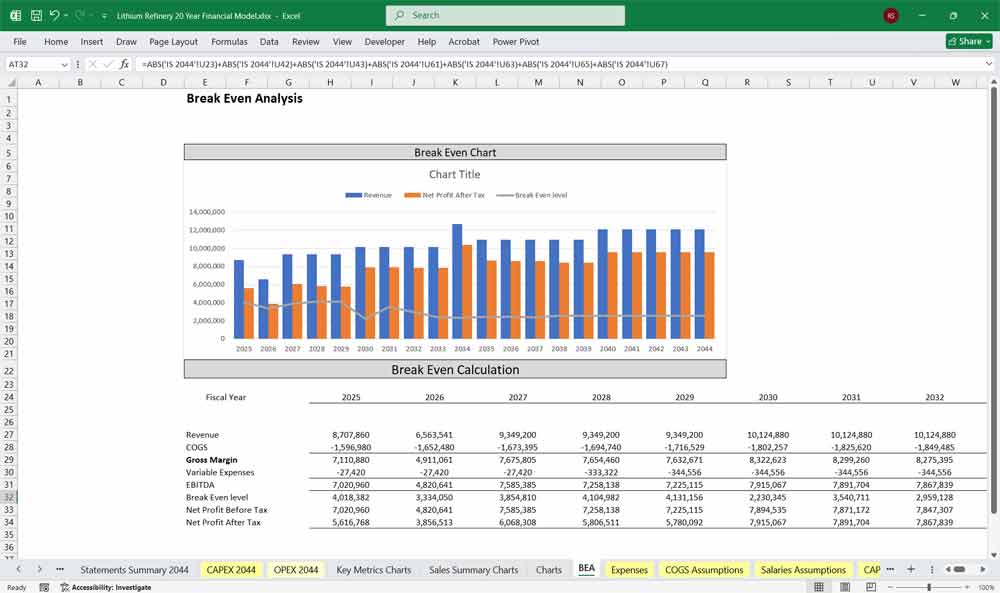
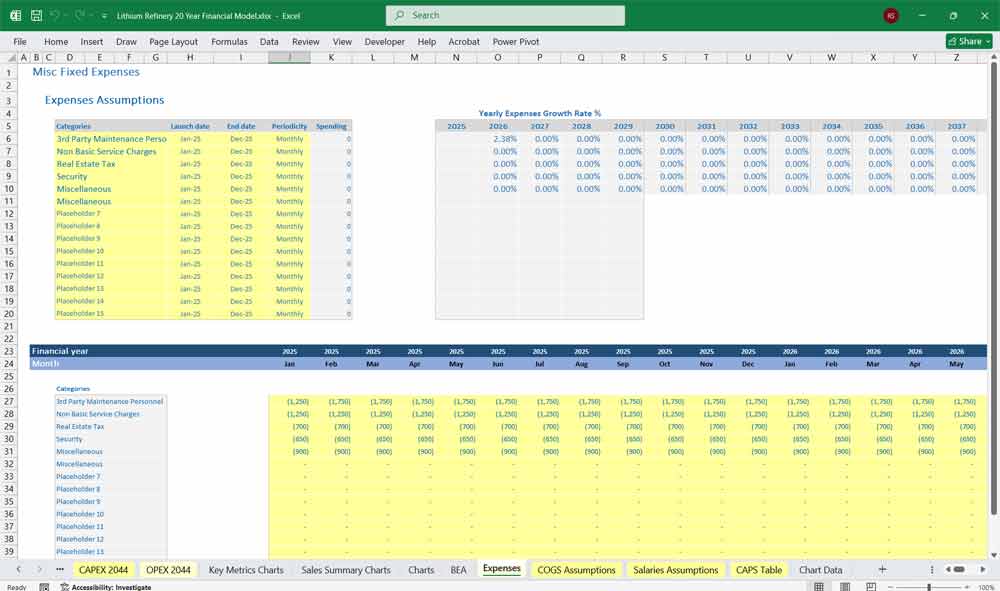
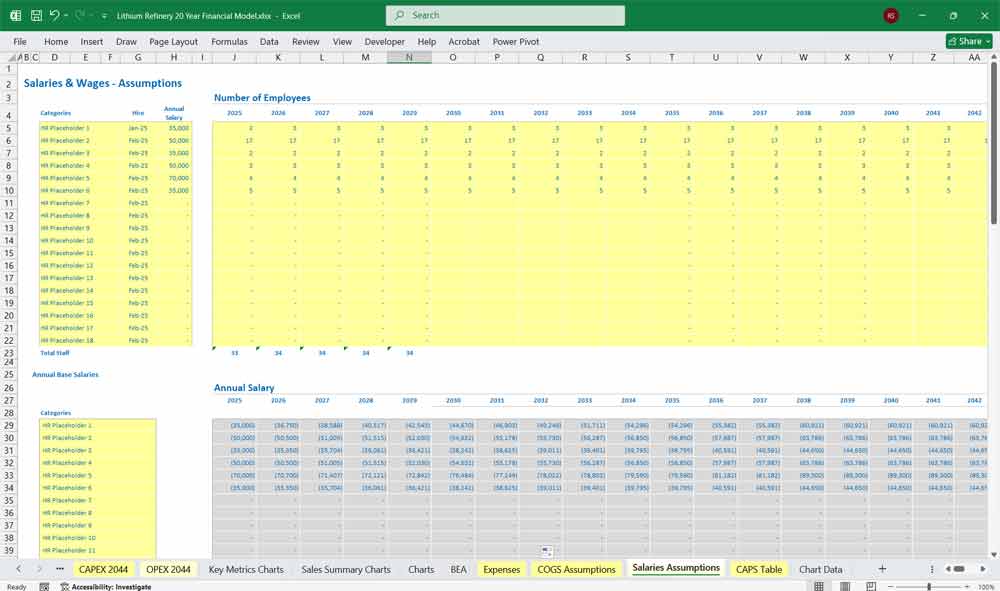
Final Notes on the Financial Model
This 20 Year Lithium Refinery Financial Model must focus on balancing capital expenditures with steady revenue growth from diversified subscription-based services. By optimizing operational costs and power efficiency and maximizing high-margin services like Lithium Carbonate and Hydroxide Sales, this model ensures sustainable profitability and cash flow stability.
Download Link On Next Page
